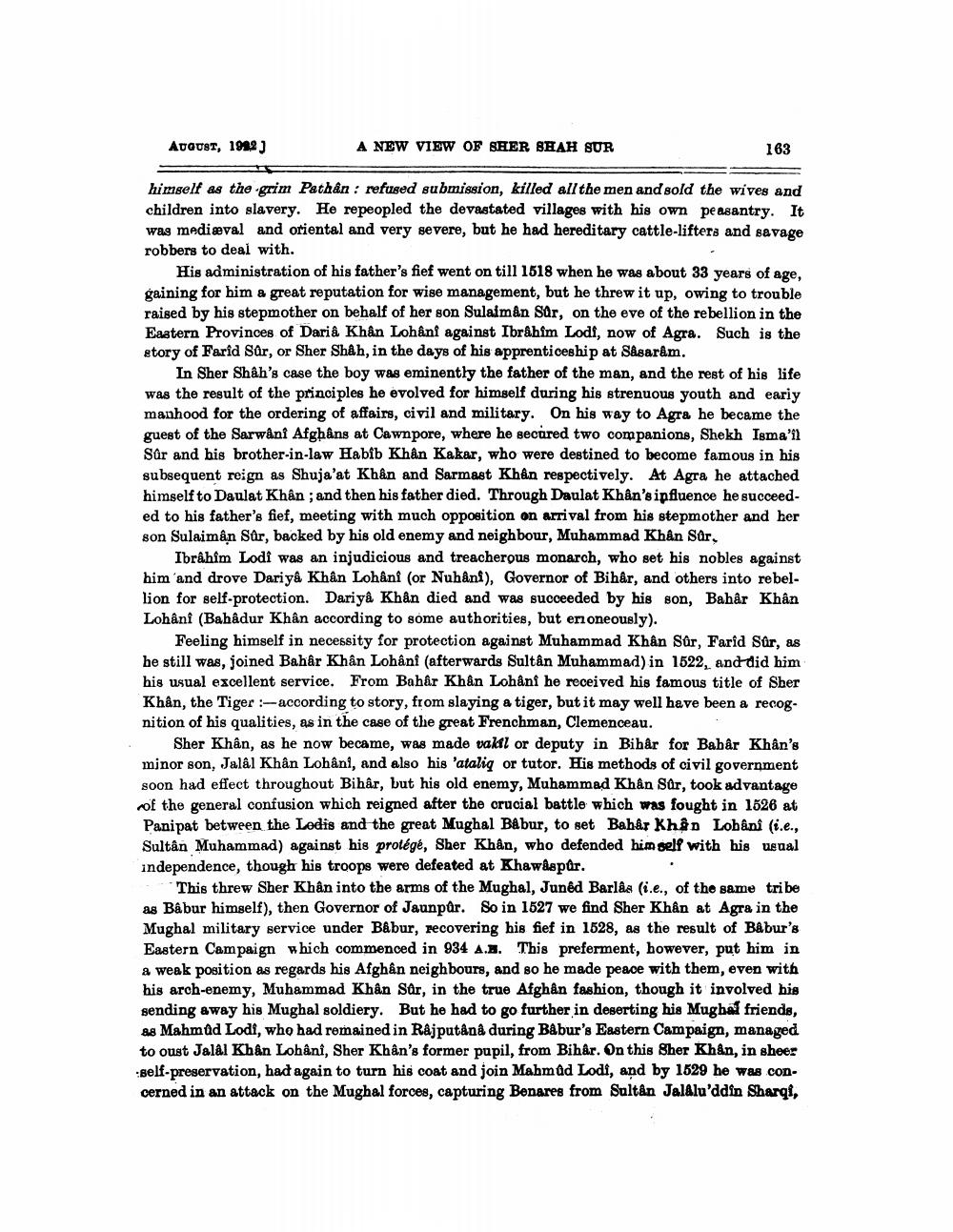________________
AUGUST, 1912)
A NEW VIEW OF SHER SHAH SUR
163
himgelf as the grim Pathån: refused submission, killed all the men and sold the wives and children into slavery. He repeopled the devastated villages with his own peasantry. It was medieval and oriental and very severe, but he had hereditary cattle-lifters and savage robbers to deal with.
His administration of his father's fief went on till 1518 when he was about 33 years of age, gaining for him a great reputation for wise management, but he threw it up, owing to trouble raised by his stepmother on behalf of her son Sulaiman Sør, on the eve of the rebellion in the Eastern Provinces of Daria Khân Lohani against Ibrahim Lodi, now of Agra. Such is the etory of Farid Sur, or Sher Shah, in the days of his apprenticeship at Såsarêm.
In Sher Shah's case the boy was eminently the father of the man, and the rest of his life was the result of the principles he evolved for himself during his strenuous youth and eariy manhood for the ordering of affairs, civil and military. On his way to Agra he became the guest of the Sarwani Afghans at Cawnpore, where he secured two companions, Shekh Isma'il Sur and his brother-in-law Habib Khân Kakar, who were destined to become famous in his subsequent reign as Shuja'at Khan and Sarmast Khán respectively. At Agra he attached himself to Daulat Khân ; and then his father died. Through Daulat Khan's influence he succeeded to his father's fief, meeting with much opposition on arrival from his stepmother and her son Sulaiman Sur, backed by his old enemy and neighbour, Muhammad Khan Sar.
Ibrahim Lodi was an injudicious and treacherous monarch, who set his nobles against him and drove Dariya Khân Lohani (or Nuhani), Governor of Bihar, and others into rebellion for self-protection. Dariya Khân died and was succeeded by his son, Bahar Khân Lohânî (Bahadur Khân according to some authorities, but erroneously).
Feeling himself in necessity for protection against Muhammad Khân Sâr, Farid Sør, as he still was, joined Bahar Khân Lohani (afterwards Sultan Muhammad) in 1522, and did him his usual excellent service. From Bahir Khân Lohani he received his famous title of Sher Khân, the Tiger :- according to story, from slaying a tiger, but it may well have been a recog. nition of his qualities, as in the case of the great Frenchman, Clemenceau. .
Sher Khân, as he now became, was made valil or deputy in Bibâr for Babár Khân's minor son, Jalal Khân Lohani, and also his 'atalig or tutor. His methods of civil government soon had effect throughout Bihår, but his old enemy, Muhammad Khân Sur, took advantage of the general confusion which reigned after the crucial battle which was fought in 1526 at Panipat between the Lodis and the great Mughal Babur, to set Bahar Khan Lobani (i.e., Sultan Muhammad) against his protégé, Sher Khan, who defended himself with his ueaal independence, though his troops were defeated at KhawAspur.
This threw Sher Khân into the arms of the Mughal, Juned Barlaa (i.e., of the same tribe as Babur himself), then Governor of Jaunpur. So in 1527 we find Sher Khân at Agra in the Mughal military service under B&bur, recovering his fief in 1628, as the result of Babur's Eastern Campaign which commenced in 934 A... This preferment, however, put him in a weak position as regards his Afghan neighbours, and so he made peace with them, even with his arch-enemy, Muhammad Khân Sûr, in the true Afghan fashion, though it involved his sending away his Mughal soldiery. But he had to go further in deserting his Mughal friends, as Mahmud Lodi, who had remained in Rajputând during Babur's Eastern Campaign, managed to oust Jalal Khan Lohânî, Sher Khan's former pupil, from Bihår. On this Sher Khan, in sheer -self-preservation, had again to turn his coat and join Mahmad Lodi, and by 1529 he was concerned in an attack on the Mughal forces, capturing Benares from Sultan Jalalu'ddin Sharqi,




